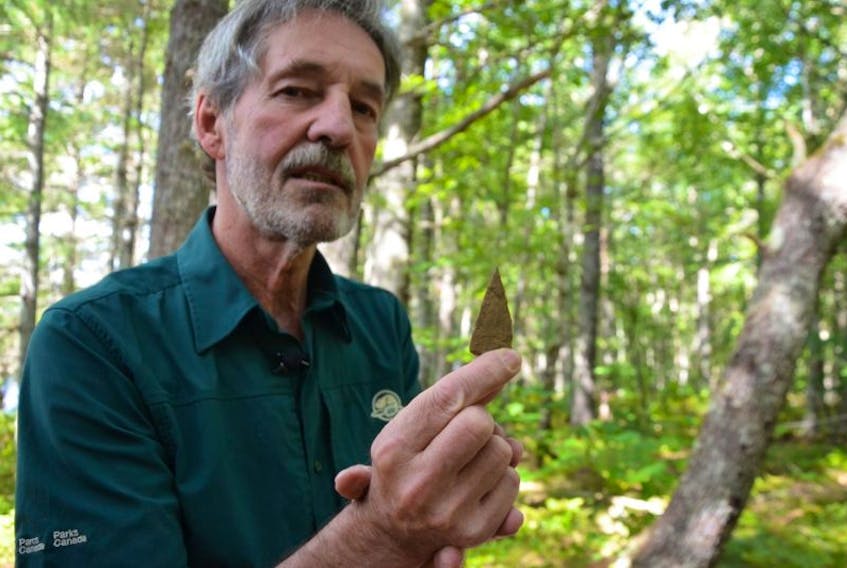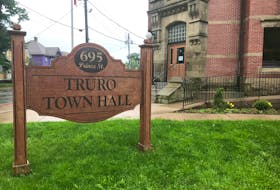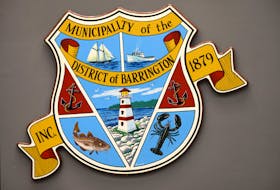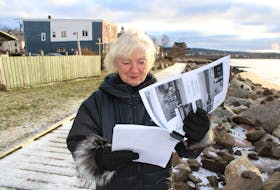She’s at Eel Weir Bridge Sept. 21 deep in the park – exactly eight kilometres from where the pavement ends -- at a site that shows continuous Mi’kmaq use dating back perhaps 6,500 years.
She thinks about the lives of the people who would have used such tools.
And while those Eel Weir Bridge treasures are staggering in themselves, Parks Canada archeologist Charles Burke puts it in a broader context that suggests bigger things.
“One thing to keep in mind, from Annapolis Royal to Liverpool there are an estimated 250 known indigenous archeological sites which makes up the Mersey River corridor – it contains 25 per cent of all the (indigenous) archeological sites in Nova Scotia,” he said.
He’s standing beside the Mersey where construction crews are building a new bridge that will span 150 feet across the water without touching it. Both sides are an archeologist’s dream.
For the millennia between 6,500 years ago and 1,400 years ago – even up to 500 years ago – the Mersey River is a huge archive of archeological evidence of the Mi’kmaq heritage in Nova Scotia, he said.
“So from that perspective, once you consider the artifacts and the features associated with the artifacts and the numerous petroglyphs that are found along the river system – all the way – then you do see that this is a very significant component of Mi’kmaq heritage in Nova Scotia, or Mi’kma’ki,” Burke said, using the indigenous term for the Mi’kmaq Nation.

People’s Lives
“We knew that there were extensive archeological sites here from work that was done in the 1970s,” said MacLean, an archeologist with Mi’kmaq Rights Initiative. “This is just a continuation of that research and what we’re able to learn from that is a continuation of people’s lives. That’s what archeology aims to do is learn about people themselves. It’s not about an arrowhead. It’s about the person who was connected to that arrowhead.”
She’s in awe of what they’ve found, and what it means.
“It’s absolutely incredible the size and the longevity of Mi’kmaq occupation along the Mersey River, especially in this area,” she said. “It’s wonderful and unbelievable. It’s just astounding. We will learn new things. The excavations that were done in the 1970s were just kind of a little bit of testing and this will provide a larger amount of information that we can analyze and make inferences from.”
This year’s archeological work had to be done.
“As part of the replacement of the older bridge with the new bridge we undertook an archeological assessment which suggested we had to do some serious testing in the area,” said Burke. “Essentially the nexus of most of the sites in the park on the river are in that location. So that’s where we had to put a lot of effort and focus in, and perhaps as many as 50 test pits were excavated and thousands of artifacts were found.”

Heritage Protection
MacLean works out of the Kwilmu’kw Maw-klusuaqn Negotiation Office in Millbrook and has been working with Parks Canada on the project to look after Mi’kmaq interests.
“For us this happens through a formal consultation process so that we’re able to provide our input on the archeological methodologies before the construction begins,” she said. “It’s important to insure the protection of Mi’kmaq archeological heritage and resources. And working together to insure the heritage is protected before there’s adverse effects from the construction is important.”
She said construction wouldn’t take place, or would be halted if there were going to be adverse effects, or damage, or loss of Mi’kmaq archeological sites or resources.
“I think it’s working,” she said of the process. “I think it provides a good opportunity for both Parks Canada and the Mi’kmaq Nation to work together to develop new collaborations -- opportunities to a develop better and stronger archeological processes overall.”

What They Found
The dig unearthed artifacts that have been taken to the Parks Canada Archeology Lab in Woodside, Dartmouth.
“We found stone tools, projectile points mostly,” said Burke. “Tips of bayonets, scrapers, and a great amount of debitage which is the chipped flakes from the creation of stone tools. That is probably the bulk of the thousands of artifacts that were found – this debitage which is in the area. But that’s proof I believe that they were actually making the tools there at the site.”
Most of the tools are made from chert, a sedimentary rock that when chipped with another stone forms razor-sharp edges.
His belief that the site was in continuous use by the Mi’kmaq for many millennia comes from being able to date many of the artifacts.
“We have artifacts as old as the archaic era which would be five to six thousand years before the present and right up to recent woodland which is 500 to 1,500 hundred years ago,” he said. “So it was occupied consistently through all this time period. Maybe not every year but it would be a regular place that Mi’kmaq people would stop. Most likely summering, just given the availability of the natural resources in that location in terms of waterfowl, fish, eels etc.”
There are eel weirs there from the 19th century, and Burke describes it as a very narrow location on the Mersey River and an ideal location for not only procuring food but smoking it or drying it.

No Pottery
Burke said there were no post-contact artifacts found in the 2017 excavations. And there were no organics at all.
“In the 1970s they did find 19th century material in the Mi’kmaq context,” he said, and note there was no pottery found which he would have expected. He said the presence of pottery separates the Woodland Era from the previous Archaic Era.
“Throughout Nova Scotia when you’re in Woodland Era sites, you do find pottery,” he said. “We haven’t found any pottery at all in 50 test pits that were excavated here. That’s unusual, but it could be simply a matter of where we placed our tests – we could have been six inches away from an intact pottery vessel.”
Back athe the archeology lab, the artifacts they did find will get processed, inventoried, and interpreted as part of the archeological evidence.
“Each artifact – all of its diagnostic attributes will be recorded, an attempt will be made to date it, associate it with a specific time period,” he said. “There’s a plan afoot at the moment to see if we have a sufficient number of artifacts that might be created as reproductions so they can be used on site as part of the interpretive program.”
The archeologist in charge of the project is Dr. Martin Perron in Parks Canada’s Ottawa office. He’s responsible for analyzes and interpretation and an eventual report -- by sometime in the spring of 2018.
In the meantime, construction crews are working on the bridge. There’s a red rope on one side of the river just south of the construction. MacLean said there’s another one across the river. They indicate where workers and machinery can’t go. There’s more history buried there.











